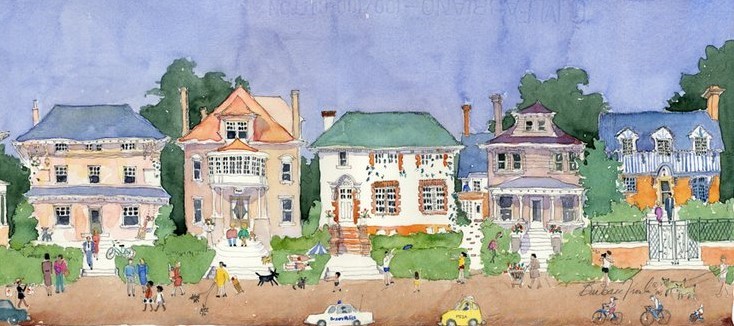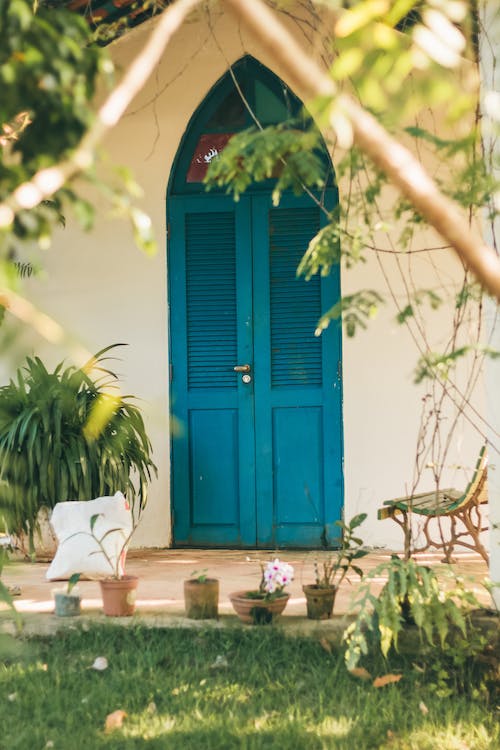
Home is far more than an abode or financial investment, it’s our refuge and sanctuary, where the dark aspects of the world are kept out and the best of earthly delights are let in. Keeping the worst of worldly life out protects our peace and tranquility. Letting the best of earthly life in invites joy and pleasure, essential to being happy.
After all, home is where life is celebrated with family and friends, blessed by sweetness, beauty, and love. It’s where children enjoy love so deep their hopes shall remain forever unbounded!
In addition to fun, Mother Nature uses pastimes, recreations, and activities to release natural chemicals that keep the body hale and hearty, along with the mental rest to restore your zest and vigor.
The outside world may offer wonder and awe, along with enthralling entertainment and recreation, as well as cultural and educational opportunities, but it can’t provide these gifts and blessings: “Home Sweet Home.”
If reverence is the key for something to be “sacred,” and not necessarily a religious connection, home is indeed sacred space.
Nest Egg Strategy protects the sacred space by reducing the chance of being “underwater,” owing more than the house is worth. By reducing the outstanding balance on the way to paying off the mortgage by age 50-55, the risk of foreclosure in a down market is reduced to almost nil. Peace of mind is priceless!
Unfortunately, as the cares and woes of the outside world, its tragedies and travesties have encroached into every part of our homes. Losing sight of its role as a refuge and sanctuary, people are taking greater financial chances
Re-establishing a better balance between worldly affairs and earthly delights, restoring home as a true refuge and sanctuary, is the test of our times.
After all, we’ve let our homes become mere extensions of the outside world. Telecommunications and Technology (T&T) led the way.
It may have brought entertainment, information resources, and productivity tools that helped people be more effective in their careers and personal pursuits, as well as allowed advances in science, medicine, and technology. But, under the guise of “staying informed,” it also let the fears and woes of the world occupy every room in the house. It made the concerns of the world your personal concerns as well. As fear increases, peace and tranquility decreases.
Technology and telecommunications has also changed the etiquette between employers and employees. Once upon a time, not long ago, employees weren’t bothered when off work at home, except for emergencies. Now, they’re rarely considered “off work,” especially information and office workers. Now the boss contacts them any time of the day, usually to do an assignment for the following work day. It’s not the extra time that’s so much of a problem, as the loss of mental rest needed to restore their zest and vigor; another reason why they’re always tired.
The more it becomes an extension of the “world,” the more people see their home like any other “investment.” As such, they’re tempted to go out on a limb to maximize their “return on investment,” usually by increasing their debt. Not only can that backfire if the market falls, but it also increases their stress and anxiety. They end up biting their bottom lip for years on end.
In addition to limiting our financial vulnerability by reducing the loan balance, now it the time to start putting the world back in its place! This includes putting T&T, (technology and telecommunications) including Social Media, smartphones, and all the rest, back in balance with the need for privacy, peace and tranquility. Victorians kept a separate room for such worldly affairs, we can do the same!
There’s no time to waste. Indeed, protecting the sacred space is the test of our times.
(Visit www.homeassacredspace.org for an elaboration of this important subject.)
None of this will happen by itself, however. It needs champion to be in charge!
* “Home as Sacred Space” is dedicated to Pierre Delattre, 1930 – 2022,
“Countless hours spent helping other pursue their vision.”
Also to Dorothea and Alphonse Cunningham
“Whose quiet lives and fierce devotion made all the difference.”

I. Champion of Refuge and Sanctuary
It’s time to resurrect the Champion of Refuge and Sanctuary. This is a responsibility that goes back to ancient Greece and Rome. Back then, it was the woman of the household who held that responsibility. That’s why her wedding was staged like a royal coronation, a queen who had dominion over her realm. Nowadays, given all the other responsibilities, it’s a rotating and shared responsibility.
Exactly how is up to each family. It’s not about splitting up chores per se, but establishing “protocols” based on good judgement and discernment that balances the outside world with the ancient need to protect their “privacy,” peace of mind.
He or she must have the judgement and discernment to put sensible limits on intrusions from the outside world. This creates an equilibrium that preserves home as a refuge. Once preserved as a refuge, it naturally evolves into a sanctuary for the joys and pleasures of life; sweetness, beauty, and love. In addition, the everyday pleasure of peace and tranquility,
Peace and tranquility are more than just feel-good terms. To be “tranquil” is to be free of disturbance, confusion, commotion, agitation, anger, worry, doubt, and especially fear. “Peace” is more than absence of war, it’s actually absence of opposition in thought, word, and deed, especially thought. A home that’s free of disturbance and opposition is one where people can enjoy mental rest, restore their zest and vigor.
Little of which is possible without a Champion of Refuge and Sanctuary. Otherwise, the world is too powerful, too entertaining, and too “connected” to enjoy peace and tranquility. He or she is essential to establishing an equilibrium between the world and their refuge and sanctuary, preserving home as sacred space.
(For a more complete elaboration on the Champion, see www.homeassacredspace.org

II. Sanctuary
The ultimate objective of protecting your home as a refuge from the travails of the world is so it can become a sanctuary for the joys of earthly life.
People typically think of “sanctuary” as some high-minded concept, its benefits on the ethereal plane. They also tend to think people should be quiet and reserved in a sanctuary, a place where all is still.
Actually, it’s quite the opposite. Unencumbered by concerns of the world, home is a sanctuary for activities, recreations, and pastimes that are key to one’s health because they release natural chemicals, endorphins and dopamine, that rejuvenate our strength and energy, while improving our outlook.
In addition to being fun, active participation in pastimes are key to being happy. For example, time with family, especially the children, homework, playing games, conversation and discussions, hobbies, cooking, pets, reading, music, gardening, bird watching, exercise, and other pastimes too numerous to list. Ironically, they’re so common and unremarkable that we tend to overlook how they fill our soul with joy and pleasure.
We also don’t appreciate how they help us forge connections with others, the first step in learning how to build meaningful associations and relationships. Which, study after study, has shown to be a critical element in being happy over a long life.
Not least, activities, recreations, and pastimes are also key to the mental “rest” we need to rejuvenate our spirits, our enthusiasm. Ironically, people often misinterpret “rest” to mean inactivity, which has the opposite effect. People sit on the couch and wonder why they’re still tired, don’t feel energized. Actually, the more active, the better. That’s why it’s called re-creation!
The Champion plays a key role is using his or her sanctuary to its best advantage. Rest, health, and happiness of the entire family are too important to leave it to chance.
(For a more complete elaboration of Sanctuary, see http://www.homeassacredspace.org

III. Signs and Symbols
One reason a home feels warm and loving is because they have “decorations” that are “personal and emotional” in nature, unlike hotel rooms that feel cold and impersonal no matter how sophisticated the interior design. They feel personal and emotional because they point to sweetness, beauty, and love, revolving around the family, which also indicate that home is a refuge and sanctuary, sacred space. Accordingly, they’re actually “signs and symbols,” not just decorations.
There are no formulas or design books for indicating which sign or symbol is right for your family, ideal for a particular room, best for the type of house or geographic region. The champion instinctively picks the right ones by following his or her heart, which makes it an art!
Historically, the Man of the House is typically in charge of “base building systems,” such as the landscape, roof, siding, plumbing, electrical, HVAC, and similar systems. Despite the Champion being a shared responsibility nowadays, the Lady of the House usually has the final vote when it comes to decorations that go into the house.”
Most people fail to appreciate just how many signs and symbols there are in their own homes, hundreds! If they consider just a few areas, it’ll soon become apparent there are far more than they thought. And, they couldn’t imagine being without them.
They actually start start at the front gate, proceed to the landing, threshold, and front door. Continue in the foyer, living room, fireplace, dining room, bedrooms, and every other room in the house.
Examples of signs and symbols in a typical home can be found in a web site devoted exclusively to home as a sacred space. See:
Home as Sacred Space
The behavioral equivalent of signs and symbols are “customs and traditions” Signs and symbols are seen, while customs and traditions are acted out. (Every culture has their own, the importance and meaning of which are known to their people, far and wide.)
Customs and Traditions:
Customs, traditions, rituals, practices, and other behaviors revolve around the notion that a person’s home is equivalent to the national “palace and cathedral” and its inhabitant’s are to be treated like kings and queens.
Everyday etiquette are scaled down versions of more formal customs and traditions.
Such customs and traditions were actually carried down from the national “Cathedral” and Palace. Simply put, the etiquette shown an actual King and Queen, is the same etiquette to be shown “Doris of Dayton, Ohio,” for example. Likewise, the etiquette shown in the national Cathedral is the same etiquette to be displayed in another person’s home, since they’re both sacred space.
For example, the “good manners” show Queen Elizabeth at Buckingham Place is the same etiquette to be shown “the “Lady of House” in every home. Everyone stands when the “queen” enters a room. A chair is held out when it’s time to sit. Topics of conversation are only those she approves of. Everyone stands at the dinner table until she sits down. When they do, it’s unthinkable that anyone would pick up their utensils and start to eat before the queen does! When the Monarch stands to leave the table, or room, everyone does likewise.
The same is true for modeling one’s behavior in a home. Since the national Cathedral (Synagogue, Temple, et al) is a holy place, and a home is a holy place, the customs and traditions, etiquette, practiced in the “Cathedral” are the same ones to be practiced in a person’s home.
Men remove their hats, for instance. Briefcases and other “business” accouterments are left outside. Voices are lowered. Their host leads the ceremonies and discussion. At the end of their visit, everyone gives thanks and bid farewell at the door.
Even the physical design is similar. Outside, there’s usually a path leading to the landing and front door. It’s customary for a vestibule or foyer to act as a transition area. Religious and spiritual symbols at the door protect the inner sanctum from the profane of the world.
Indeed, “a man’s home is his castle.” After witnessing the etiquette common to an average home and a nation’s palace and cathedral, it’s clear that customs and traditions are the behavioral equivalent of signs and symbols, reminding everyone that home is sacred space.
A Last Word
Everyone in their heart knows that home is sacred space, (they feel personally violated when burglarized). Even so, more and more, it has become an extension of the outside world, its concerns and woes becoming the focus of attention at home too. As such, it’s less of refuge and sanctuary and becoming more of an abode, a good investment. A Champion of Refuge and Sanctuary is needed to reverse this trend.
He or she needs to “keep the home fires burning.” That is, first and foremost, make sure it’s a refuge from the travails of the “world,” and ensure it’s a sanctuary for the joys of “earthly” life. Next, adopt the Nest Egg Strategy and thus ensure there’s enough hard-dollar equity to withstand a downturn in the real estate market, never “underwater,” and never at risk of foreclosure.
All of this is important to adults. It’s even more important to children. Mr Rodgers said that “trust” is one of the first things children learn at home. With trust, they can embrace “hope.” Which is more than fond ambition, but a faith so profound that periodic disappointments shall never undo their optimism, their enthusiasm forever unbounded.
Home is indeed Sacred Space!
(Visit http://www.homeassacredspace.org for a complete exploration and elaboration on home as sacred space.)
* “Visit to Capital Hill,” Copyright Barbara Froula 1985
© Copyright, Cunningham Advisors LLC., 2023
Disclaimer: Note: This website is used with the understanding that it does not constitute financial, legal, accounting, or professional advice. Although the data should prove useful, neither we or any party assumes liability for the accuracy, merchantability, or fitness of this data. All warranties, expressed or implied, are excluded

